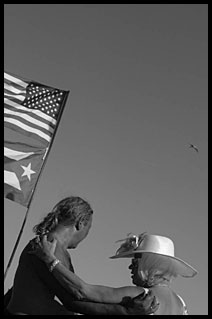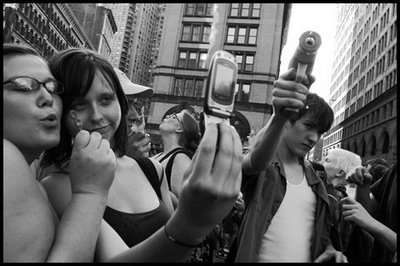Have you ever been in the middle of telling a story and realized you don't remember the punchline? I was telling someone about how lucky I'd been this last term about seeing great documentary filmmakers talk about their work, and I was detailing some of the highlights:
Frederick Wiseman analyzing his editing choices in a talk at the Walter Reade Theater; D.A. Pennebaker, at The New School, discussing shooting the performances in Monterey Pop; Peter Davis discussing the controversy over "The Selling of the Pentagon"; Richard Leacock at IFC Center showing some rarely-seen films and telling all the stories that went with them.... (At this last event, my impression was that half the documentary filmmakers in New York were in attendance: Michael Moore stood by the back door; Albert Maysles rushed in late and Pennebaker, as he walked to the stage, made a crack about his wind-blown hair.)
While I was telling these stories, I began to wonder what the point was. I don't really believe standing in the same room with some of the greats lets any magic rub off of them and onto you, so it wasn't about that. Was it about the fact that they were all still working, and at as high a level as ever? (I believe they all have films in progress or about to come out.)
After some consideration, I think the point was this: seeing the real people who made the films talk about them made me demystify the way these films were created. Films are made out of choices at the camera and at the editing station; and these choices come out of the experiences and ideas of the people who make them. No more, no less.
Sunday, December 31, 2006
One Last Thing
Posted by Ted Fisher at 11:55 AM 0 comments
Sunday, December 24, 2006
Thursday, December 21, 2006
1,178,284 or so
Well, the original Project Redeye video is now the "18th Most Viewed (All Time) in Arts & Animation" on YouTube.
So, here's Project Redeye 2: "Holiday Photo Challenge" edition.
Posted by Ted Fisher at 10:43 PM 0 comments
Tuesday, December 12, 2006
New School Faculty Overrun Sundance
I am impressed:
Five faculty members from the Department of Media Studies and Film will have their work shown at this year’s Sundance Film Festival in Park City, Utah, to be held in January 2007. Another faculty member Lewis Erskine will serve on the Documentary Jury. The five films and their directors/media faculty include:
Everything's Cool, directed by Judith Helfand and Daniel B. Gold, examines a group of self-appointed global warming messengers who are on a high-stakes quest to find the iconic image, proper language, and points of leverage to help the public go from embracing the urgency of the problem to creating the political will necessary to move to an alternative energy economy. World Premiere.
Ghosts of Abu Ghraib, directed by Rory Kennedy and edited by Media Studies/Documentary Studies faculty member Sari Gilman, looks at the abuses that occurred at the infamous Iraqi prison in the fall of 2003 by using direct personal narratives of perpetrators, witnesses, and victims to probe the effects of the abuses on all involved. World Premiere.
Hot House/Israel, directed by Shimon Dotan, provides an unprecedented look at how Israeli prisons have become the breeding ground for the next generation of Palestinian leaders as well as the birthplace of future terrorist threats. North American Premiere.
Freeheld, directed by Cynthia Wade, tells the story of Lieutenant Laurel Hester, who while dying of cancer, fights to leave her pension to her domestic partner, provoking an enormous battle in New Jersey. World Premiere.
Posted by Ted Fisher at 9:18 PM 1 comments
Saturday, December 09, 2006
Mixed Messages, Mixed Drinks

Last night was the "Mixed Messages 2006" event.
12th and 3rd in Brooklyn showed on the big screen, and looked good. The audience laughed in the right places and applauded strongly. (If I were re-editing, I might reconsider the "false endings" or at least re-time them, but the point is that it played well with a large audience.) I thought the rest of the program was strong, too, and I was surprised that there were several documentaries screening. We did not have to resort to weeping. John Cameron Mitchell and the show's organizers gave out the awards.
We received "Special Recognition for Narrative Documentary" and an envelope containing various prizes.
Of course, I'm not a reliable reporter of the whole process: once they called our names, my brain sort of stopped working in its normal fashion (not because awards are a big deal, but because I have a tough time in front of any audience of any size) and I only have partial memories of going on stage, getting photographed, and the rest of the process. I have much clearer memories of going out after. The point, of course, is that Documentary is not about awards. It's clearly about Cucumber Martinis all around....
Posted by Ted Fisher at 6:00 PM 0 comments
One Meeeeeeeeeeeelion and Two
The sequel to the "Project Redeye" video for youtube has been shot.
(Because the first one left so many unanswered questions. Like "Why did you post this, exactly?" and "Doesn't youtube.com watch these things before putting them on the front page?" and many, many others.)
Higher production values. Slightly improved lighting. Coming to a youtube screen near you....
Posted by Ted Fisher at 1:45 PM 0 comments
Wednesday, November 29, 2006
One Meeeeeeeeeeeelion Views
So I make a lot of videos. Once in a while one gets broadcast. Sometimes they are shown in galleries. Usually, at best, they go to film festivals and get seen by a few hundred people.
Well, at one of my jobs I was volunteered to help with a video. So I helped. I shot it and edited it, on a very fast deadline. Not my usual sort of video. It went up on youtube.com before Halloween, and when I looked the next day it was on the main page and had about 29,000 views. "Wow," I thought. "That's a lot of views." It stayed on the main page about a week.
Now, it has just made it past 1,000,000 views. Six zeroes. Seriously. It's about 7 minutes long, so it is fair to say this video has consumed 7,000,000 minutes of potentially productive time. That's 116,666 hours. 4,861 days. More than 13 years -- gone.
I would just like to take this moment to apologize for that.
It is currently the number 19 most-viewed video of all time in the "Arts and Animation" category. If you feel you must see it, it's at: Project Redeye. A production meeting for the sequel is being held on Friday.
Posted by Ted Fisher at 10:52 PM 1 comments
Sunday, November 26, 2006
Return to Bigton
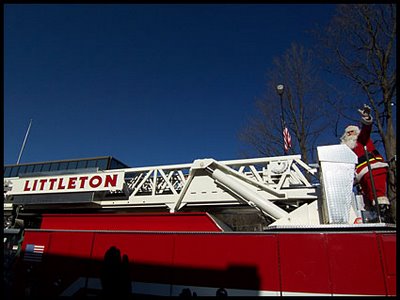
This blog had a brief and very pleasant vacation in New Hampshire, but has now returned. (Above, an image from the first parade of the season, held Friday morning on Main Street.)
Posted by Ted Fisher at 4:35 PM 0 comments
Wednesday, November 15, 2006
12th and 3rd at Mixed Messages
For "12th and 3rd in Brooklyn," Iris Lee, Maya Mumma and I are "finalists" in:
Mixed Messages 2006
Friday, Dec. 8, 7:00 p.m., Tishman Auditorium, 66 West 12th Street. Free admission.
The selection email said: "An independent panel of distinguished jurors reviewed the many outstanding submissions ... and competition in all categories was strong. The final round judges chose 1 audio work, 1 multimedia project, 2 films and 5 videos."
So, as they say, just being nominated is an honor.
I'm trying, however, to convince Maya and Iris that if we don't win something, anything, we should just weep uncontrollably until they give us something or forcibly escort us from the building.
Posted by Ted Fisher at 8:12 PM 1 comments
Pay No Attention to the Man Behind the Curtain
Ah, a lot has been going on, and I've been so overwhelmed I haven't been posting it.
I hope to get back to regular posting this weekend....
Posted by Ted Fisher at 8:05 PM 0 comments
Saturday, October 14, 2006
It's Not About Pit Bulls, Exactly
I started a new documentary project today -- on Street Photographers. Research and planning have gone on for a while, but today was the first day of rolling tape.
So I went to Central Park with students from my Extension Class at Hunter College. It was a beautiful day, and there was an event for dogs and their owners. Picture hundreds and hundreds of dogs, most of exceptional breeding. It's Manhattan, after all.
The idea was to get some footage of the process of making photographs in public. My students were great, experimenting with many ideas and shooting some very interesting pictures. It was fun to see them work.
The strange part was that the park was filled with Documentary crews. I ran into some who were there to shoot pieces on dogs, on dog owners, on dog fashion, and on the wackiness of how dogs are treated in affluent and decadent Western culture.
And I ran into a woman who is shooting a documentary. She asked what we were shooting -- well, actually "Who are you shooting for?" -- and then didn't seem to listen to the answer. She was noticeably relieved when it turned out not to be a documentary on Pit Bulls, though. I know this because when I asked her what she was shooting she seemed a bit hesitant to tell me, and then told me it was on Pit Bulls -- almost in a whisper.
Was she afraid to admit this in the middle of the sea of dog owners? (You have to figure it might be some sort of expose....) Or was she afraid we might steal her idea?
Posted by Ted Fisher at 4:08 PM 0 comments
Tuesday, October 10, 2006
A Decades-Long Research Period
When I got to hear D.A. Pennebaker speak a while back, he mentioned that you might want to do some living before making documentaries. He said it in a more elegant way than that, mentioning Hemingway along the route, but he said it nonetheless.
I like that idea, of course. And it's a great excuse for almost anything, as well.
"Why did I do that? It's research. Research I say!"
Posted by Ted Fisher at 8:06 PM 0 comments
Monday, October 09, 2006
New School Video Show
"12th and 3rd in Brooklyn" (Directed by Iris Lee, Maya Mumma and Yours Truly) screened again -- this time at "The New School Video Show" on Friday night.
I actually did not know in advance that it was definitely going to show, so I gave no notice to anyone. And then I was sick and didn't attend the screening. (So the tree fell, but I never heard it....)
I went to the 2005 version of that show (not very long after I moved to New York) and thought: "I could make something for this...."
A lot has happened since.
Posted by Ted Fisher at 10:24 AM 0 comments
Thursday, October 05, 2006
If You Buy Only One Book This Year
Well, it might be because that's all you can carry....
It's finally out: 480 pages of street photography happiness. Elliott Erwitt's Personal Best.
Posted by Ted Fisher at 10:25 PM 0 comments
Sunday, October 01, 2006
A Decent Week All Around
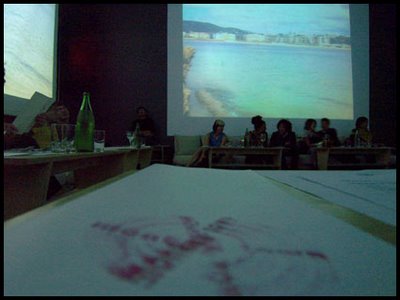
I had a good week. On Thursday, I saw D.A. Pennebaker present his films in person. He showed his early "Daybreak Express" and "Baby" -- both excellent short documentary films. It's nice to get to be in the same room as one's heroes...
Then on Friday night Maya Mumma, Iris Lee and I screened our new documentary short 12th and 3rd in Brooklyn (New York Portrait #1) at Monkeytown. Great place. You sit on slinky couches, drink wine, and look up at the four huge screens.
Also: finally bought an HDV camcorder: the JVC GR-HD1. I've unpacked it and charged the batteries....
Above: Monkeytown is great, as long as you like to watch things, eat, drink, and sink into a couch.
Posted by Ted Fisher at 1:53 PM 2 comments
Tuesday, September 26, 2006
Another Reflex Set on Automatic
So I was in Union Square doing a camera test with a new video camera. I bumped into a class shooting street photographs.
One of the students came over to ask if she could take my photograph, and talked about how tough it was for her to photograph people she didn't know.
We talked for a while, and I videotaped her a bit, and asked her a few questions. We talked for a moment about the ethics of street photography, and the experience of the process, and the sort of uncertain exchange that usually occurs.
I don't think she took my picture.
Posted by Ted Fisher at 9:59 PM 0 comments
Saturday, September 23, 2006
12th and 3rd in Brooklyn
Won't you take me to... Monkeytown.
My documentary short "12th and 3rd in Brooklyn" is scheduled to screen there in a program called "Witness the Fitness" on Friday, September 29. Admission is $5 and showtimes are 7:30pm and 10pm. (Reservations are recommended.) Monkeytown is at 58 N. 3rd St, (between Kent & Wythe) in Williamsburg, Brooklyn.
The show intro says:
"It's Sports Vs. Art in the ultimate showdown for cultural supremacy! Be there LIVE to see artists wrestle with their athletic inadequacy, battle their alienation, and GO FOR THE GOLD, facing off against seasoned veterans from the spectrum of professional sports."(Note that "12th and 3rd in Brooklyn" is co-directed by Iris Lee and Maya Mumma.)
Posted by Ted Fisher at 9:25 AM 0 comments
Tuesday, September 19, 2006
What Would Fred Wiseman Do?
I've been away from the blogging for one week finishing the Documentary short I mentioned previously. It's done. Might change a little -- post-critiques -- but it's essentially done. It took some work, though.
Two days shooting plus eight days editing equals a six-minute piece.
One highlight from that period: I saw Fred Wiseman speak and show clips from some of his movies in a session at Lincoln Center. Incredible presentation, really, as he skipped all the expected niceties and just spent time analyzing his own work. I learned more about approaching documentary structure while listening to him than from the last 10 books I've read....
Posted by Ted Fisher at 10:00 PM 1 comments
Tuesday, September 12, 2006
As True as it Needs to Be

Any story depends on telling, and more so than we'd like to think.
The documentary project I'm working on -- loosely connected to stickball -- proceeds well enough. I've copied over about 1,600 stills, and about 5 hours of video. Now it just needs a beginning, a middle, and also an end.
Above: Brooklyn, September 10, 2006.
Posted by Ted Fisher at 12:35 AM 0 comments
Monday, September 11, 2006
On the Streets of Brooklyn
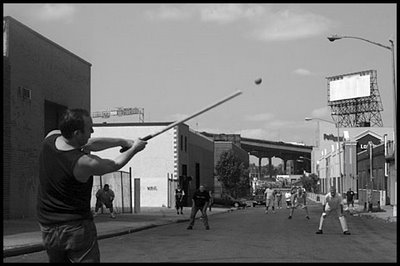
As far as I know, it was Elliott Erwitt who said, "If you don't go, there are no pictures."
And as far as I know, it was Weegee who said, "F8 and be there."
Above, Stickball, 12th Street, Between 2nd and 3rd Avenues, Brooklyn.
Posted by Ted Fisher at 12:15 AM 0 comments
Saturday, September 09, 2006
The Sporting Life

I'm working on a very short documentary about New York. Stickball is a part of it, but also I'm hoping it will connect to some other ideas on youth and fun -- and my dislike of the regimented, the rank-and-file and the serious.
I'll let you know how it goes....
Posted by Ted Fisher at 11:25 PM 1 comments
Thursday, September 07, 2006
Wednesday, September 06, 2006
The Worst Students Make the Best Teachers
Starting September 15th I'm teaching Seriously Fun Photography at Hunter College Continuing Education. If enough people sign up, that is. So sign up. It's meant to be an easy-going way for people to move into advanced photography -- low pressure, but a high level of photo skills development. The listing in the catalog reads:
Build on the basics and master the skills and ideas advanced photographers use in a fun, low-pressure class. Open to anyone able to shoot a photo and import it into a computer (and welcoming advanced students as well), in this class we'll use the digital camera as a fast way to learn the essentials of photography. We'll learn-by-doing, exploring professional techniques while creating a portfolio project (on any topic of your choice) to show your advanced skills. If you've always been interested in photography, but have put off becoming great at it, this is your chance. Tuition: $225.00
Instructor: Ted Fisher
FRI 5:30:PM - 7:30:PM Location: TH 4th Fl
09/15 - 10/27 Sessions: 6 Skips 9/22
Posted by Ted Fisher at 10:40 PM 0 comments
Tuesday, September 05, 2006
The Street Photography Bookshelf
I have a lot of photography books, many specifically on Street Photography and Documentary Photography. So I'll occasionally recommend a book or two for those who want to know more about the genre....
Today I'd like to recommend The Social Scene.
It's an exhibition catalog put together by the Museum of Contemporary Art in Los Angeles for a show held in 2000, but I think the work lends itself to the book form well: it allows you to sit down and spend time with some great photographs that reward slow browsing.
If you don't happen to already have dozens of photography books on your shelves, it's a great way to get introduced to the "usual suspects" -- including photographers Diane Arbus, Brassai, Robert Frank, Lee Friedlander, Helen Levitt, Danny Lyon, and Garry Winogrand.
The kicker is that the essays included (by Emily Apter, Cornelia H. Butler, A.D. Coleman, Liz Kotz, and Max Kozloff) are excellent and valuable -- not filler as is found in so many exhibition catalogs.
Enjoy.
Posted by Ted Fisher at 11:40 AM 0 comments
Monday, September 04, 2006
A Change of Season
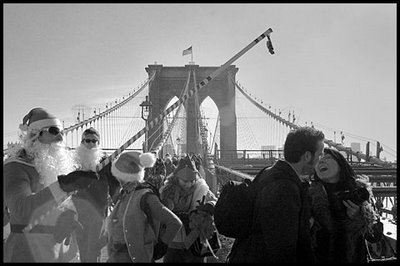
I've been looking at a great deal of photography lately: street photography, documentary photography, digital photography, and just-plain photography.
If I see one more photograph which could be described in the following manner, I will scream:
A person stands before the camera with a surprisingly empty look on their face.Please, can this go out of fashion sometime soon?
Above: Mistletoe, Brooklyn Bridge.
Posted by Ted Fisher at 1:00 PM 0 comments
Sunday, September 03, 2006
Photography Unmasked
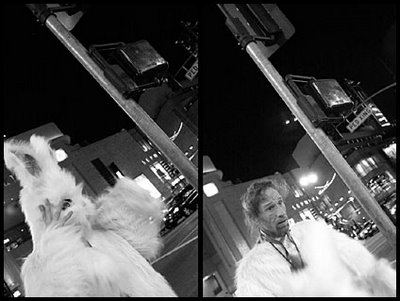
I'm puzzled by the fact that concern for "photographic truth" seems to be on the increase. I'm tired of hearing media reports that claim to be "shocked, shocked" at "faked" images. I'm also tired of reading that an exhibition "examines a contemporary notion of photographic reality," as a review in this month's Aperture Magazine claims.
Is it that the folks who write about such things do so in an overly-complicated manner? Let me be clear, then:
There is no photographic truth. There never has been. It does not matter. Let it go. Now go make some pictures.
Posted by Ted Fisher at 3:10 PM 0 comments
Saturday, September 02, 2006
I Hear Weegee Laughing

I've been trying to decide on a small point-and-shoot camera to carry around. One that will fit in a pocket, but still make good street photographs when I stumble on an interesting situation.
Ironically, I was thinking about this on Friday morning as I walked along 86th Street and saw the sidewalk ahead closed off in police tape. I thought about it more as I got closer, and saw several police officers walking about and staring at the ground. Scattered at their feet: a stack of cash, green bills fluttering, splashed red from an exploded dye-pack.
I thought about it very hard as I walked past, no photograph made.
Above: an image from my street photography portfolio Waiting for the April Fool's Parade (copyright 2006 Ted Fisher).
Posted by Ted Fisher at 10:55 AM 0 comments
Friday, September 01, 2006
This Weekend in the Galleries
Take the weekend off. Take a deep breath, and prepare for an endless stream of New York gallery openings in the next two weeks. My plan is to see everything, but here are a few suggestions to get you started:
Ron Galella at Paul Kasmin Gallery, 293 Tenth Avenue.
(Opens Wednesday, September 6, 6-8 p.m.)
Hey, Hot Shot! at Jen Bekman, 6 Spring Street.
(Opens Thursday, September 7, 6-8 p.m.)
Nancy Burson at ClampArt, 521-531 West 25th Street.
(Opens Thursday, September 7, 6-8 p.m.).
Nathan Lyons at Bruce Silverstein Gallery, 504 West 22nd Street.
(Opens Saturday, September 9th, 6-8 p.m.)
Posted by Ted Fisher at 9:10 AM 0 comments
Thursday, August 31, 2006
It Keeps Me Off the Streets
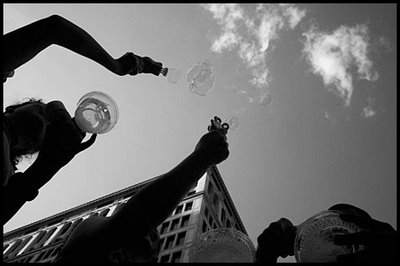
I've let my camera rest these last two weeks while I've been editing the last project and sorting out the next. So, of course, I have had a number of unphotographable moments. Three I have missed:
A man with Down's Syndrome gently swinging a child's purse and hitting an older man again and again. (The older man said: "Since you are going" whack "to live with me for two weeks" whack "we're going to need" whack "to establish" whack "some ground rules.")
A man walking casually down 1st Avenue with a plastic bag over his head, seemingly quite comfortable and at home in his bag.
A couple kissing so intensely on the steps of the Metropolitan Museum that even New Yorkers turned to look.
Above: an image from my street photography portfolio Waiting for the April Fool's Parade (copyright 2006 Ted Fisher).
Posted by Ted Fisher at 9:37 AM 0 comments
Wednesday, August 30, 2006
An Artist Deals with Banality
And how do you find the mystery in the banal?Above: an image from my street photography portfolio Waiting for the April Fool's Parade (copyright 2006 Ted Fisher).
Garry Winogrand: Well, that's what's interesting. There is a transformation, you see, when you just put four edges around it. That changes it. A new world is created.
Does that discreet context make it more descriptive, and by transforming it give it a whole new layer of meaning?
Garry Winogrand: You're asking me why that happens. Aside from the fact of just taking things out of context, I don't know why. That's part of a mystery. In a way, a transformation is a mystery to me.
Posted by Ted Fisher at 12:03 AM 0 comments
Tuesday, August 29, 2006
Street Photography or Documentary Photography?
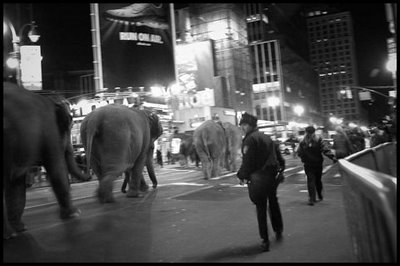
If there were an actual April Fool's Parade -- instead of just a way of looking at passing daily life -- it would be the perfect test for whether one wants to practice Street Photography or Documentary Photography.
In my take -- and I'm perfectly willing to let everyone invent their own version -- two photographers might show up at the same parade. The first, practicing documentary photography, will stay with the parade, and end up telling some story out of it, though perhaps not the obvious one....
The second, engaged in street photography, will be distracted by something, somewhere off to the side of the parade route, something vaguely beautiful but difficult to see....
Above: an image from my street photography portfolio Waiting for the April Fool's Parade (copyright 2006 Ted Fisher).
Posted by Ted Fisher at 12:10 AM 0 comments
Monday, August 28, 2006
What I Saw on the Walls
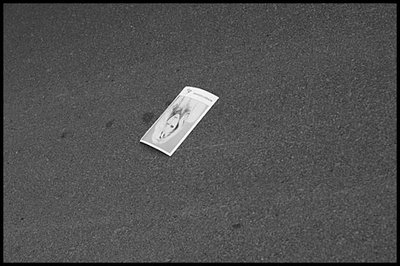
This weekend's viewing included visits to the International Center of Photography, the Neue Galerie and the Metropolitan Museum of Art.
Weegee's street photography (showcased in ICP's Unknown Weegee) is fantastic, but presents a curatorial dilemma every time it is shown. Weegee's body of work is large and uneven. Do you trim a show down to the absolute gems, and lose the sense of the day-to-day Weegee, grinding out photos for cash, or do you show the less-fantastic images to tell the full story -- and thus leave Weegee's reputation suffering in comparison to photographers we only know from their best images?
Gustav Klimt's Adele Bloch-Bauer I -- now known as "the most expensive painting in the world" -- has made the Upper East Side's Neue Galerie a very crowded place this summer. It's a case study in how different an object can be from its photographic reproduction. Spend time with this painting in a book or on a computer screen, and then see it in person for two minutes... and decide for yourself.
It's the third time I've seen the Met's On Photography: A Tribute to Susan Sontag. It's an excellent show that works as a collection of images, and as a way to consider the nature of photography -- and whether it functions differently than any other art.
Above: an image from my street photography portfolio Waiting for the April Fool's Parade (copyright 2006 Ted Fisher).
Posted by Ted Fisher at 12:22 AM 0 comments
Sunday, August 27, 2006
The Untimely Death of Henri Cartier-Bresson
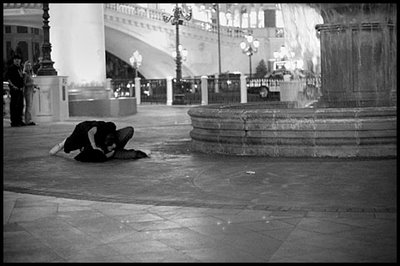
Popular Photography has an interesting tidbit on Henri Cartier-Bresson:
The French photographer had been captured by Nazis in 1940, and he had spent 35 months in various prisoner-of-war camps. After two unsuccessful attempts at escape, he finally succeeded. In 1943, he dug up the Leica he had buried on a farm near Vosges and began taking pictures again.As always, chance works on its own terms.
By the end of the war, however, rumors reached America that Cartier-Bresson had been killed. MoMA's photography curator, Beaumont Newhall, went to work on a major show. Then, in 1946, it was learned that he was still alive. Cartier-Bresson decided to come to America to work on the exhibition -- a show that helped to establish him as a major figure in photography and art.
Above: an image from my street photography portfolio Waiting for the April Fool's Parade (copyright 2006 Ted Fisher).
Posted by Ted Fisher at 1:30 PM 0 comments
When Did "New Documents" Stop Being New?
Just finished reading "Two Jacks and a Jill: Diane Arbus, Lee Friedlander, Garry Winogrand, and the Judgment Seat" by A.D. Coleman, a short essay in the April / May 2005 Camera Arts magazine. (Yes, I am aware that magazine came out 16 months ago -- bear with me here.)
Coleman, referencing the February 28, 1967 "New Documents" exhibition at New York's Museum of Modern Art, quotes Curator John Szarkowski's text introducing the show:
"In the past decade a new generation of photographers has directed the documentary approach toward more personal ends. Their aim has been not to reform life, but to know it. Their work betrays a sympathy -- almost an affection -- for the imperfections and frailties of society. They like the real world, in spite of its terrors, as the source of all wonder and fascination and value -- no less precious for being irrational..."and points out that maybe -- just maybe -- there's something troubling about placing photographs that reveal "the imperfections and frailties of society" into an aesthetic that considers them as "formal play with neutral (if ironic), apolitical observation of human social behaviour...."
I like Coleman's point: these works, charged and loaded with all sorts of political and social content, were effectively "framed" as being somehow divorced from the concerns that "documentary photography" had carried previously. They were positioned to be like abstract paintings, when they were clearly the opposite.
Score: Museum Wall Text 1, Photographs, 0.
Posted by Ted Fisher at 12:35 AM 0 comments
Saturday, August 26, 2006
448 Pages of Elliott Erwitt
I love having something to anticipate.
On October 15th a new Elliott Erwitt book will be released: Personal Best. Amazon says:
"Elliott Erwitt personally selected this stunning collection of work, two thirds of which have never been published before."
That seems grammatically incorrect, but I'm excited about it anyway. It's a 448-page hardcover. It costs $78.75. (That's only 17 cents per page, so don't quibble.)
Let the countdown begin.
Posted by Ted Fisher at 10:27 AM 0 comments
Friday, August 25, 2006
Man Ray in the Bargain Bin
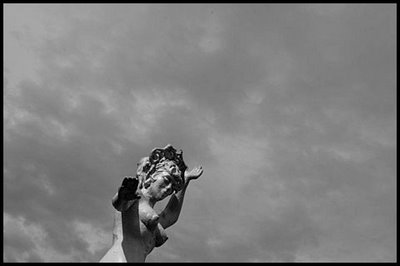
Just bought a bargain-priced book on Man Ray. It had some images that don't appear in my other Man Ray books, so I felt my $6.98 was well spent.
No photographs in the book appear to have any element of accident in them. They're completely planned and constructed. I guess that you could say they are examples of what you can make up in the laboratory.
I still like them anyway, I guess, though I worry they'll make Elliott Erwitt mildly angry.
Above: an image from my street photography portfolio Waiting for the April Fool's Parade (copyright 2006 Ted Fisher).
Posted by Ted Fisher at 9:00 PM 0 comments
This Weekend in the Galleries
Three shows are about to close at International Center of Photography:
Unknown WeegeeGo! Go now!
Tempo, Tempo! The Bauhaus Photomontages of Marianne Brandt
Atta Kim: On-Air
Posted by Ted Fisher at 12:34 AM 0 comments
Thursday, August 24, 2006
Waiting for the April Fool's Parade

On August 12th -- my one-year anniversary in Manhattan -- I shot the last photos needed to finish my first official New York street photography project. A lot of folks who know my work seem confused that I'm returning to the practice of "Street Photography," although they've all been too polite to point out the 1970s are long over.
Secretly I think it's funny that any form of art that's fun could fall out of favor. That is, I understand how it might lose its audience -- "Oh, we saw that last season in Prague" -- but I can't understand how it can lose its practitioners.
Above: an image from my street photography portfolio Waiting for the April Fool's Parade (copyright 2006 Ted Fisher).
Posted by Ted Fisher at 1:05 AM 0 comments
Wednesday, August 23, 2006
Ruth Orkin, Street Photographer
Enjoyed The Fearless Reader's post on Ruth Orkin, "a photographer and filmmaker whose pictures, since her death from cancer in 1985, are better known than her name."
"Orkin, like Lisette Model before her, practiced the art of street photography. Her images freeze recognizable human moments in the frame, catching the unexpected and the whimsical along with way. Easter Sunday shows a handsomely attired woman regarding her counterpart in a window at Saks Fifth Avenue as a policeman stands nearby, lost in thought. Several shots taken at Penn Station catch people waiting for trains: a man balancing a box on his hip; a curly-headed tot enthroned on a suitcase in the middle of a crowd; a mother absentmindedly restraining a restless child. A woman lost in thought as she selects produce at an outdoor market is another recurring theme."
Full article:
THE FEARLESS READER: A Modern Brueghel
Posted by Ted Fisher at 7:38 PM 0 comments
What Would Elliott Erwitt (Not) Do?

Elliott Erwitt, in an NPR interview from Friday, March 7, 2003:
"I deplore what's happened to our craft, which has been undermined by people changing pictures electronically -- or digitally or whichever way they do it -- which undermines the entire good thing about photography, which is supposed to be a representation of what is, rather than what you can make up in the laboratory."
Right: because the real world is frozen in black and white with everything lined up just so, as it appears in Erwitt photographs....
Don't get me wrong, I love Erwitt's photography and his approach, and he seems like a wonderful guy. I think his reputation will only continue to grow, and he's one of my favorite artists. But I just don't think it matters -- outside of news photography -- if a photograph lies in some way. Of course it lies, it's a photograph -- it lies in many ways by its nature. Let it alone.
"But how is reality, or photography for that matter, threatened?"
(The Elliott Erwitt interview is available in RealMedia format and the quote is from about 5:45 into the piece.)
Above: an image from my street photography portfolio Waiting for the April Fool's Parade (copyright 2006 Ted Fisher).
Posted by Ted Fisher at 1:30 AM 0 comments
Frank Lennon, 1927 - 2006
Photographer who captured Henderson's winning goal dead at 79
(From CBC Arts.)
Frank Lennon, 79: Captured Canada's joy
(From The Toronto Star.)
"Whenever somebody asked him about 'the photo,' Lennon, a lifelong jokester, delighted in telling the story of how it happened. There he was at Moscow's Luzhniki Arena, he would deadpan. He was staring up at the rafters, admiring the struts on the ceiling when this Red Army soldier walked by and accidentally bumped into him, causing him to push the shutter."
Posted by Ted Fisher at 1:05 AM 0 comments
Tuesday, August 22, 2006
A Pyramid, or a Sphinx
Well, what is it about a photograph that makes it alive or dead?
Garry Winogrand: How problematic it is! It's got to do with the contention between content and form. Invariably that's what's responsible for its energies, its tensions, its being interesting or not.
There are photographs that function just to give you information. I never saw a pyramid, but I've seen photographs; I know what a pyramid or a sphinx looks like. There are pictures that do that, but they satisfy a different kind of interest.
Most photographs are of life, what goes on in the world. And that's boring, generally. Life is banal, you know. Let's say that an artist deals with banality. I don't care what the discipline is.
Above: an image from my street photography portfolio Waiting for the April Fool's Parade (copyright 2006 Ted Fisher).
Posted by Ted Fisher at 1:36 AM 0 comments
Monday, August 21, 2006
Joe Rosenthal, 1911-2006
Iwo Jima Photographer Rosenthal Dies
From AP (via Yahoo News):
"Out of the corner of my eye, I had seen the men start the flag up. I swung my camera and shot the scene," he said a decade afterward. "That is how the picture was taken, and when you take a picture like that, you don't come away saying you got a great shot. You don't know."
Joe Rosenthal, Iwo Jima Photographer, Dies at 94
From Popular Photography:
"Probably more than any other 20th Century photographer, Joe Rosenthal was responsible for the concept of the photographic icon," says Dirck Halstead, former White House photographer for Time Magazine and editor and publisher of The Digital Journalist.
Posted by Ted Fisher at 11:00 PM 0 comments
Joel Meyerowitz on iN-PUBLiC

I'm a fan of the work of Joel Meyerowitz, so I'm very pleased to find that he's joined the fine folks at iN-PUBLiC.
I remember, in the early days of the Web, meeting with many established photographers who were simply terrified of posting on the Internet. I think now folks have calmed down and realized you can have a Web presence and not give away the seed corn. So I like watching the Web slowly turn into a showcase for photography -- the sort of quick-access library for photographers that I remember wishing for when I first studied the medium.
The iN-PUBLiC Meyerowitz portfolio is here: Joel Meyerowitz.
You can also view Joel Meyerowitz Photography, LLC.
Above: an image from my street photography portfolio Waiting for the April Fool's Parade (copyright 2006 Ted Fisher).
Posted by Ted Fisher at 5:00 PM 0 comments
What Would Elliott Erwitt Do?
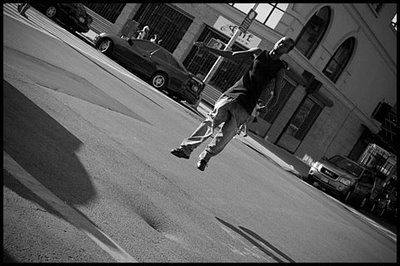
On most days, my favorite photographer is Elliott Erwitt.
His sense of humor is obvious. Unfortunately, it's easy to miss what's more important about his work: he's visually one of the sharpest photographers out there, and he notices invisible things constantly -- and finds some way to show them to you.
His online portfolio is here: Elliott Erwitt.
Take a look, and the next time you find a camera in your hands, ask yourself: WWEED?
Above: an image from my street photography portfolio Waiting for the April Fool's Parade (copyright 2006 Ted Fisher).
Posted by Ted Fisher at 12:37 AM 0 comments
Sunday, August 20, 2006
New York Street Photography
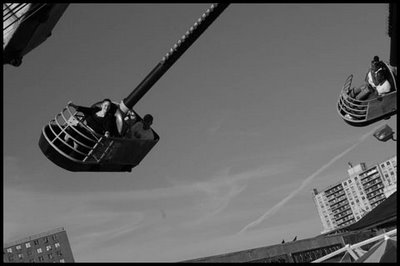
My first day in New York was August 12, 2005. One of the goals I arrived with was to go back to my roots: street photography.
I have a couple of degrees in photography, and I spent five years as a curator in a photography museum. Somehow, though, over the years I had moved far away from my first love in photography: the idea of simply wandering with a camera -- no particular place to go....
The first photos I ever saw that I felt lived up to the full potential of the medium were the street photos of photographers like Garry Winogrand, Elliot Erwitt, Helen Levitt, Lee Friedlander, Robert Frank, and many others. I liked these for many reasons, one being that they seemed to be an effort to answer the question: "What is life like?"
So a year has passed, and I have completed my first street photography portfolio. The last day shooting was August 12, 2006.
Above: an image from my street photography portfolio Waiting for the April Fool's Parade (copyright 2006 Ted Fisher).
Posted by Ted Fisher at 11:26 AM 0 comments
Saturday, August 19, 2006
Happy 167th Birthday

On January 7, 1839, Louis Daguerre showed the French Academie des Sciences something he just knew they were going to love: some photographs. But it was on August 19, 1839, that the process used to make the images was explained before both the Academie des Sciences and the Academie des Beaux-Arts. (Much has been made of this dual announcement, as photography is considered both art and science.)
Traditionally, this is the date known as the birthday of photography, when the process was made known to the world -- as a gift from the French government.
We know, of course, that many people experimented with the new medium before this date, and that permanent photographs were made as early as 1826. The "official" date matters, though, because the efforts of those first pioneers had little impact on the world. It is only after the new process went out into the world that something really new began.
Above: an image from my street photography portfolio Waiting for the April Fool's Parade (copyright 2006 Ted Fisher).
Posted by Ted Fisher at 5:02 PM 0 comments
Beginnings and Endings
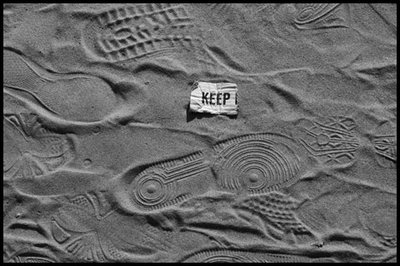
Three quotes from Burning with Desire: The Conception of Photography by Geoffrey Batchen:
"Faced with the invention of photography, French painter Paul Delaroche is supposed to have declared, 'From today, painting is dead!' Now, a little over 150 years later, everyone seems to want to talk about photography's death." (Page 207)
"Photography's plausibility has long rested on the uniqueness of its indexical relation to the world it images, a relation regarded as fundamental to its operation as a system of representation. As a footprint is to a foot, so is a photograph to its referent. ... For this reason, a photograph of something has generally been held to be a proof of that thing's being, even if not of its truth. Computer visualization, on the other hand, can produce photographic-style images with apparently no direct referent in an outside world. Where photography is inscribed by the things it represents, digital images may have no origin other than their own computer programs." (Pages 212 - 213)
"But how is reality, or photography for that matter, threatened? It should be clear to those familiar with the history of photography that a change in imaging technology will not, in and of itself, cause the disappearance of the photograph and the culture it sustains. Photography has never been any one technology; its nearly two centuries of development have been marked by numerous, competing instances of technological innovation and obsolescence, without any threat posed to the survival of the medium itself."
Above: an image from my street photography portfolio Waiting for the April Fool's Parade (copyright 2006 Ted Fisher).
Posted by Ted Fisher at 12:30 PM 0 comments

